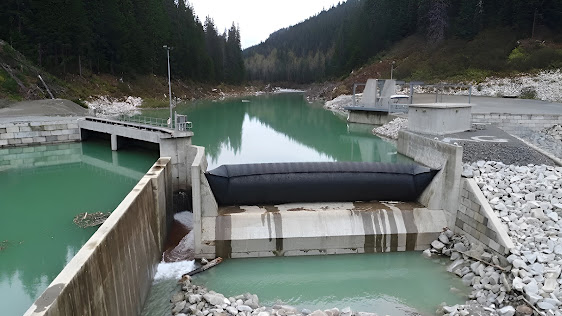The worldwide necessity of water demands proper management of flow operations because it determines how we produce food, generate energy, protect against flooding and plan urban growth. Modern river control methods have experienced a transformation through the implementation of rubber dams over the past few years. Yooil Envirotech has emerged as one of the leading modern water control solution developers worldwide. Hydraulic engineering benefits from rubber dams, which have changed the management landscape throughout India and other regions despite their essential role in water distribution.
What Are Rubber Dams?
The flexible inflatable rubber dams consist of reinforced rubberized fabric materials. These dams are positioned across waterways through which engineers can introduce water or compressed air to create barriers before deflating them for natural water movement. The main functions of these aquatic structures include flood control, management of irrigation systems, groundwater recharge operations, hydropower production and water storage purposes.
The installation process for rubber dams goes quickly while traditional concrete dams do not while maintenance needs are minimal and rubber dams present a greener option. The flexible nature of rubber dams makes them ready for usage in both rural and urban infrastructure needs.
Types of Rubber Dams
There are different rubber dam types depending on the site requirements and construction types of specific locations. Two primary categories of rubber dams exist in addition to third-generation rubber membrane variants.
The air-inflated Rubber Dams serve for quick inflation and deflation operations through their air-filled mechanism.
Water-inflated Rubber Dams obtain enhanced stability when filled with water in comparison to varying water pressures.
A combination of air and water functions in hybrid Rubber Dams enhances their operational reliability while providing better control features.
Fixed Base Rubber Dams – Installed permanently with anchorage systems to the riverbed.
The movable base rubber dams feature both excellent installation flexibility and easy portability when redeployment becomes necessary.
The company develops custom solutions at Yooil Envirotech through specific approaches for different purposes according to terrain types and hydrological and environmental demands.
The Rise of Rubber Dams in India
With a growing population and increasing demand for water resources, India faces significant water management challenges. Traditional dams, while effective, are often expensive, time-consuming to build, and environmentally invasive. In contrast, rubber dam in India are being recognized as a game-changer in sustainable infrastructure.
Projects supported by Yooil Envirotech have demonstrated how rubber dam construction can be completed faster and with far less disruption to the local ecosystem. Moreover, India’s varied geography makes it an ideal candidate for customized rubber dam solutions—be it in the Himalayan rivers, the arid regions of Rajasthan, or the flood-prone plains of Bihar.
One notable achievement is the longest rubber dam in India, built using Yooil's advanced engineering and design technologies. This project has set a new benchmark in river management, combining efficiency with innovation.
Advantages of Rubber Dams
The advantages of using rubber dams are numerous, especially when compared to traditional barriers:
Flexibility: Rubber dams can be inflated and deflated depending on the water flow, offering real-time control.
Low Maintenance: With no moving mechanical parts, these dams require minimal upkeep.
Cost-Effective: Rubber dam construction is significantly less expensive than concrete alternatives.
Eco-Friendly: They reduce ecological impact and do not disrupt fish migration or aquatic habitats.
Rapid Installation: They can be installed in weeks rather than years, saving both time and resources.
Versatile Application: From water storage to flood prevention, they serve multiple functions.
These rubber dam advantages are at the heart of Yooil Envirotech’s vision to deliver smarter water infrastructure for a more sustainable future.
Applications of Rubber Dam Water Control
The precise offer of a rubber dam water control makes them ideal for a variety of applications:
Irrigation: Maintaining steady water levels for agricultural use.
Hydroelectricity: Supporting small-scale hydro power generation.
Urban Planning: Flood prevention and river beautification in city landscapes.
Drinking Water Supply: Enabling better water retention and distribution systems.
Through strategic placement and smart automation, Yooil’s rubber dam systems are helping governments and organizations optimize their water resources like never before.
Why Yooil Envirotech?
With decades of experience and a global footprint, Yooil Envirotech is at the forefront of rubber dam construction and innovation. The company blends advanced engineering with sustainable design, offering customized solutions tailored to specific geographic and climatic conditions. Their commitment to quality, sustainability, and innovation makes them a trusted partner for governments, municipalities, and private developers worldwide.
The Future of River Control Is Flexible
As the world grapples with the effects of climate change, resource depletion, and urban expansion, flexible and responsive water control systems are becoming critical. The different rubber dam types are no longer a futuristic concept—they are a practical, proven solution. Thanks to pioneers like Yooil Envirotech, river control is now safer, more efficient, and environmentally sustainable.
Whether it’s managing floods, supporting irrigation, or simply beautifying riverbanks, the era of smart water infrastructure is here—and rubber dams are leading the charge.




